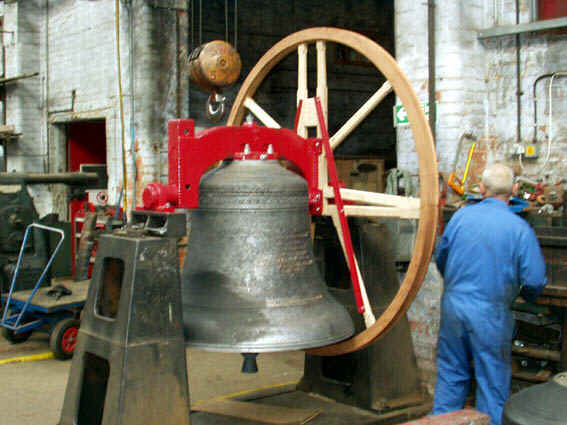Change Ringing - The Mechanics
A while back, I described the Trinity bell tower, and as I promised here is the follow up post that talks about change ringing itself. This post is going to describe the process of ringing a single bell.
Let’s start from the beginning. In a tower, there are several bells (12 at Trinity) of various pitches (tuned to make them sound pleasant).

Each bell has a head stock (red in the above photo), and a wheel for the rope. A person uses the rope to make the wheel turn, which in turn makes the bell itself move.
The headstock and the bearings are designed in such a way that the bell can freely turn 360 degrees. This might sound unsafe, and it can be. So do not just assume that you can handle it without proper supervision. There is something called a stay, which prevents the bell from going more than ~380 degrees, but it is just a piece of wood — wood can (and does) break.
The bells start off in the most unlikely position — up side down! That is, they open upward. When a tiny bit of energy is applied on the rope (by pulling), the bell goes off balance and thanks to physics, swings all the way around stopping more or less right at the top again. At some point during the swing, the clapper strikes the bell, and everyone in the neighborhood knows that someone is ringing.
Here is a great animation that I found on the internet that shows exactly what happens:

Now comes the hard part :) Since you have multiple bells, you can ring them in various orders. Suppose you label the treble as bell number 1, the tenor as 12, and all the other bells in the obvious way. You could ring them one at a time, one right after another (you want to have 12 people, one per bell). Easy enough, right? Well… go ahead an look at this video of some ringing at Trinity:
What do you think? Pretty cool, eh? There isn’t much time between each bell strike, and you want to make sure that you make your bell sound at the right time.
You might have noticed that right before the end of the video, the pattern changed. More on this in the next post.
What does it look like when the bells are moving? Well, there’s is another video. This one is about how the bells were made, and all the other good stuff. It opens with a shot of the bells swinging around:
Anyway, that’s it for the mechanics of ringing a bell, you will have to wait for the next post to find out about the patterns. I will try to write it before the 2010 is over ;)
I thought you wanted to work at Watson Labs, not Bell Labs?
Comment by [unknown] — January 1, 1970 @ 00:00